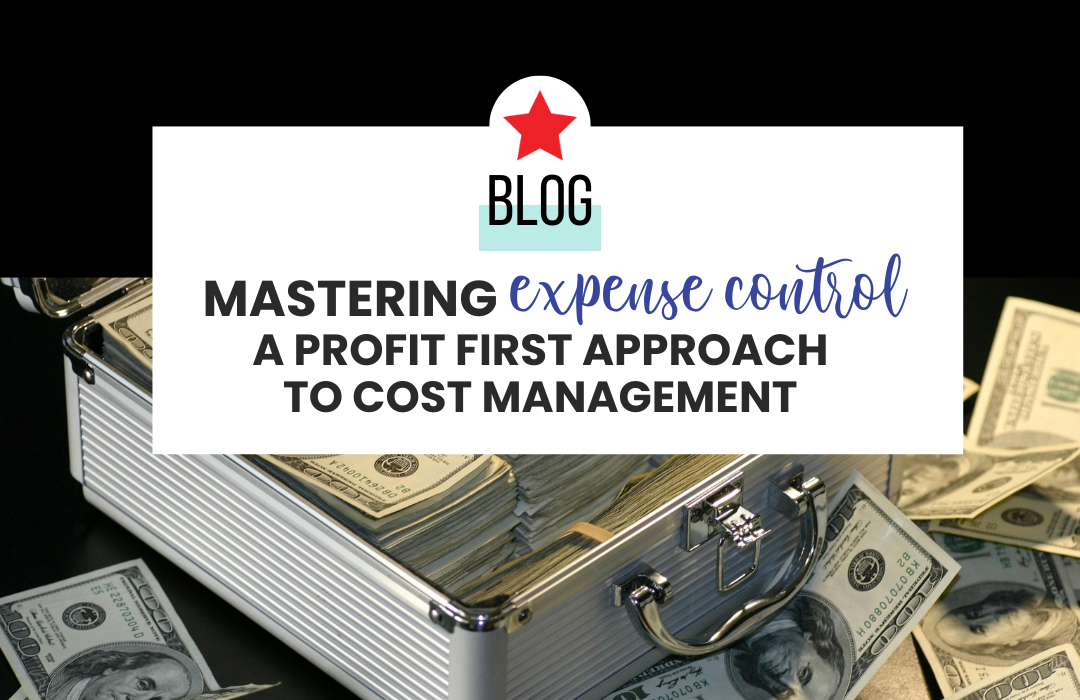[et_pb_section fb_built=”1″ _builder_version=”3.22″ global_colors_info=”{}”][et_pb_row _builder_version=”3.25″ background_size=”initial” background_position=”top_left” background_repeat=”repeat” global_colors_info=”{}”][et_pb_column type=”4_4″ _builder_version=”3.25″ custom_padding=”|||” global_colors_info=”{}” custom_padding__hover=”|||”][et_pb_text _builder_version=”3.27.4″ background_size=”initial” background_position=”top_left” background_repeat=”repeat” global_colors_info=”{}”]
In the world of business, managing expenses effectively is not just about cutting costs—it’s about making strategic decisions that enhance your financial health and sustainability. The Profit First approach, introduced by Mike Michalowicz, offers a transformative way to handle business finances by prioritizing profit and judicious expense management. This guide will share how you can apply Profit First principles to master expense control and significantly improve your business’s profitability, while also increasing efficiencies that make everything run smoother and easier.
Understanding the Profit First Methodology
Profit First is a financial management strategy that flips the traditional formula of Sales – Expenses = Profit to Sales – Profit = Expenses. This shift encourages businesses to allocate profit before paying expenses, ensuring financial gains are not merely an afterthought but a guaranteed outcome of every transaction.
The Core Components
The method involves setting up multiple bank accounts for specific allocations like profit, owner’s compensation, taxes, and operating expenses. Each time revenue comes in, percentages are allocated to each account according to predetermined percentages. This system not only simplifies cash management but also provides clear insights into how much can be spent on operating expenses without compromising profit.
Step-by-Step Guide to Expense Control Using Profit First
- Set Clear Allocation Percentages
Before you can control expenses effectively, you need to determine how much of your income should be allocated to different areas. These percentages should be based on realistic assessments of your financial reports and future goals.
- Action Tip: Start with the suggested Profit First allocation percentages and adjust based on your business’s unique needs and financial data. Ensure your profit and taxes are covered first to avoid common financial pitfalls.
- Evaluate Current Expenses
Take a thorough inventory of all your current expenses. Categorize them into essential and non-essential expenses. This assessment will help you understand where your money goes and highlight areas where cuts can be made.
- Action Tip: Use financial software or spreadsheets to track and categorize expenses. Regularly review these expenses to ensure they are still necessary and aligned with your business goals.
- Implement Immediate Cuts
With your expenses categorized, identify quick wins where you can cut costs immediately. This might include unnecessary subscriptions, redundant services, or any luxury expenses that do not contribute directly to profit generation.
- Action Tip: Prioritize cutting non-essential expenses that do not affect the quality of your products or services. Aim for reductions that will not impact customer satisfaction or business operations.
- Negotiate with Vendors
A significant part of expense management involves negotiating costs and terms with your suppliers and vendors. Building strong relationships with them can lead to more favorable terms or lower prices.
- Action Tip: Regularly communicate with vendors to discuss volume discounts, extended payment terms, or more cost-effective package deals. Loyalty and regular on-time payments can also leverage better negotiations.
- Leverage Technology for Efficiency
Technological advancements can streamline operations and reduce costs significantly. From automating accounting practices to using project management tools, technology can eliminate inefficiencies that lead to high expenses.
- Action Tip: Assess your operational processes and identify areas where technology can improve efficiency. Invest in reliable software that reduces labor costs and time spent on manual tasks.
- Monitor Expense Ratios
Regularly monitoring your expense ratios—how your expenses relate to your revenue—is crucial for maintaining financial health. Ensure your expenses are not growing proportionally faster than your income. Keeping a tight rein on this balance is key to sustainable growth.
- Action Tip: Set up a dashboard or use financial tools that allow you to visualize expense ratios in real-time. Make it a habit to review these figures monthly, adjusting your budgets and strategies as necessary to maintain or improve your ratios.
- Focus on ROI-Driven Spending
When evaluating potential expenditures, consider the return on investment (ROI). Each expense should have a clear justification and expected outcome that benefits the business, whether it’s through direct revenue generation, efficiency improvements, or critical operational support.
- Action Tip: Develop criteria for evaluating the potential ROI of new expenses. If an expense cannot be justified with a quantifiable benefit, it might not be worthwhile.
- Reinforce a Cost-Conscious Culture
Creating a culture that values cost-efficiency and mindful spending can have a profound impact on your company’s financial health. Encourage team members at all levels to contribute ideas for cost reduction and recognize those who find ways to save money without compromising service or quality.
- Action Tip: Regularly communicate the importance of expense management in team meetings and through internal communications. Offer incentives for employees who propose successful cost-saving measures.
- Use Profit First for Scalable Growth
As your business grows, your expenses will naturally increase. However, using the Profit First approach ensures that your profit margins grow concurrently. This approach can guide investment decisions in scaling operations, hiring new staff, or expanding product lines.
- Action Tip: Always revisit your Profit First percentages during periods of growth to adjust how much you allocate to expenses versus profit. This ensures that growth is always profitable and financially sustainable.
- Regularly Review and Adjust Your Financial Plan
The economic landscape and your business environment are always changing. Regularly reviewing and adjusting your financial plan allows you to stay on top of these changes and manage your expenses proactively.
- Action Tip: Schedule quarterly reviews of your financial plan. Adjust your expense allocations and strategies based on current business performance and forecasted changes in the market.
Mastering expense control with a Profit First approach isn’t just about spending less; it’s about spending smarter. By prioritizing profit, scrutinizing expenses, and making strategic decisions based on ROI, businesses can ensure their financial stability and foster long-term growth. Remember, every dollar saved in expenses is a dollar that directly contributes to your bottom line. Embrace these strategies to not only survive in the competitive business landscape but to thrive and expand with confidence.
[/et_pb_text][/et_pb_column][/et_pb_row][et_pb_row _builder_version=”4.13.0″ _module_preset=”default” global_colors_info=”{}”][et_pb_column type=”4_4″ _builder_version=”4.13.0″ _module_preset=”default” global_colors_info=”{}”][et_pb_code _builder_version=”4.13.0″ _module_preset=”default” global_colors_info=”{}”]
[/et_pb_code][/et_pb_column][/et_pb_row][et_pb_row _builder_version=”4.13.0″ _module_preset=”default” global_colors_info=”{}”][et_pb_column type=”4_4″ _builder_version=”4.13.0″ _module_preset=”default” global_colors_info=”{}”][et_pb_post_slider include_categories=”current” _builder_version=”4.13.0″ _module_preset=”default” global_colors_info=”{}”][/et_pb_post_slider][/et_pb_column][/et_pb_row][et_pb_row column_structure=”1_2,1_2″ _builder_version=”4.13.0″ _module_preset=”default” global_colors_info=”{}”][et_pb_column type=”1_2″ _builder_version=”4.13.0″ _module_preset=”default” global_colors_info=”{}”][et_pb_image src=”https://sparkbusinessconsulting.com/wp-content/uploads/2024/06/June-Blog-Template.png” title_text=”June Blog Template” _builder_version=”4.13.0″ _module_preset=”default” global_colors_info=”{}”][/et_pb_image][/et_pb_column][et_pb_column type=”1_2″ _builder_version=”4.13.0″ _module_preset=”default” global_colors_info=”{}”][et_pb_image src=”https://sparkbusinessconsulting.com/wp-content/uploads/2024/06/Copy-of-Feb-PIN-Quote-White.png” title_text=”Copy of Feb PIN Quote-White” _builder_version=”4.13.0″ _module_preset=”default” global_colors_info=”{}”][/et_pb_image][/et_pb_column][/et_pb_row][/et_pb_section]









